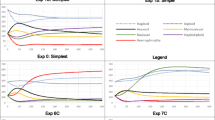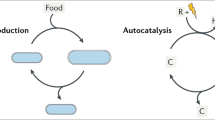Summary
The theory is presented that the sexual process is a repair mechanism which maintains redundancy within the sub-structure of hierarchical, self-reproducing organisms. In order to keep the problems within mathematically tractable limits (see Part II), a simple model is introduced: a wheel with 6 spokes, 3 of them vital and 3 redundant, symbolizes the individual (cell or organism). Random accidents destroy spokes; the wheels replicate at regular cycles and engage periodically in pairing and repair phases during which missing spokes are copy-reproduced along the intact spokes of the partner wheel.
The hierarchical structure of such a system is analysed and an ‘autonomous unit’ is defined: this is the unit of minimal hierarchical complexity which is capable of perpetuating autonomously all higher and all lower levels of the hierarchy; this is the central unit of selection.
Four basic, physical parameters are isolated which determine the essential features of any eucaryotic life cycle: 1. The number of levels of the hierarchy (unicellular, multicellular, colonial, etc.); 2. the relation between the phases of replication (asexual generations) and repair (sexual generations); 3. the duration of potential repair (haplo- diplo-phases); 4. the position of the sexual partners within the hierarchy (selfing, monecy, dioecy, reproductive individuals within colonies, etc.).
The evaluation of fitness components is considered in relation to trends of reproductive patterns in evolution.
Similar content being viewed by others
References
Cameron, I. L. & G. M. Padilla ed. (1966). Cell synchrony. - New York and London, Academic Press, 392 pp.
Conrad, M. & H. H. Pattee (1970). Evolution experiments with an artificial ecosystem. - J. Theoret. Biol. 28, p. 393–401.
Davidson, E. H. et al. (1973). Arrangement and characterization of repetitive sequence elements in animal DNA-s. - Cold Spr. Harb. Symp. quant. Biol. 38, p. 295–301.
Dobzhansky, Th. & S. Wright (1941). Genetics of natural populations vs relations between mutation rate and accumulation of lethals in populations of Drosophila pseudobflura. - Genetics 26, p. 23–51.
Eigen, M. (1971). Self-organization of matter and the evolution of macromolecules. - Naturwissenflhaften 58, p. 465–523.
Eigen, M. & R. Winkler (1975). Das Spiel. - München and Zürich, R. Piper & Co, 404 pp.
Evans, H. J. (1975). Genetic repair: Introduction by the Chairman. - Genetics 79 Suppl., p. 170–178.
Gilbert, W., N. Maizels & A. Maxam (1975). Sequences of controlling regions of the E. coli lactose operon. - Genetics 79 Suppl., p. 227.
Hamilton, W. D. (1972). The genetical evolution of social behaviour. -In: G. C. Williams ed., Group selection, p. 23–43. - Chicago and New York, Aldine Atherton.
Hanawalt, P. C. (1975). Molecular mechanisms involved in DNA repair. - Genetics 79 Suppl., p. 179–197.
Howell, S. H. & H. Stern (1971). The appearance of DNA breakage and repair activities in the synchronous meiotic cycle of Lilium. - J. mol. Biol. 55, p. 357–378.
Kelly, T. J. jr. & H. O. Smith (1970). A restriction enzyme from Hemophilus influenza. - J. mol. Biol. 51, p. 393–409.
Magni, G. E. & R. C. von Borstel (1962). Different rates of spontaneous mutations during mitosis and meiosis in yeast. -Genetics 47, p. 1097–1108.
Maynard-Smith, J. (1971). The origin and maintenance of sex. - In: G. C. Williams ed., Group selection, p. 163–175. - Chicago and New York, Aldine Atherton.
Siegel, R. W. (1958). Hybrid vigor, heterosis and evolution in Paramecium aurelia. - Evolution 12, p. 402–416.
Siegel, R. W. (1967). Genetics of aging and the life cycle in ciliates. - Symp. Soc. exp. Biol. 21, p. 127–148.
Thomas, C. A. jr., et al. (1973). Cylodromes and palindromes in chromosomes.-Cold Spr. Harb. Symp. quant. Biol. 38, p. 353–369.
Walker, I. (1972). Biological memory. - Acta biotheor. 21, p. 204–235
Walker, I. (1976). Maxwell's demon in biological systems. -Acta biotheor. 25, p. 103–110.
Walker, I. & R. M. Williams (1976). The evolution of the cooperative group. - Acta biotheor. 25, p. 1–43.
Williams, G. C. (1975). Sex and evolution. - Princeton, New Jersey, Princeton University Press, 201 pp.
Williams, G. C. & B. Mitton (1973). Why reproduce sexually? - J. theor. Biol. 39, p. 545–554.
Author information
Authors and Affiliations
Rights and permissions
About this article
Cite this article
Walker, I. The evolution of sexual reproduction as a repair mechanism. Part I. A model for self-repair and its biological implications. Acta Biotheor 27, 133–158 (1978). https://doi.org/10.1007/BF00115831
Received:
Issue Date:
DOI: https://doi.org/10.1007/BF00115831




